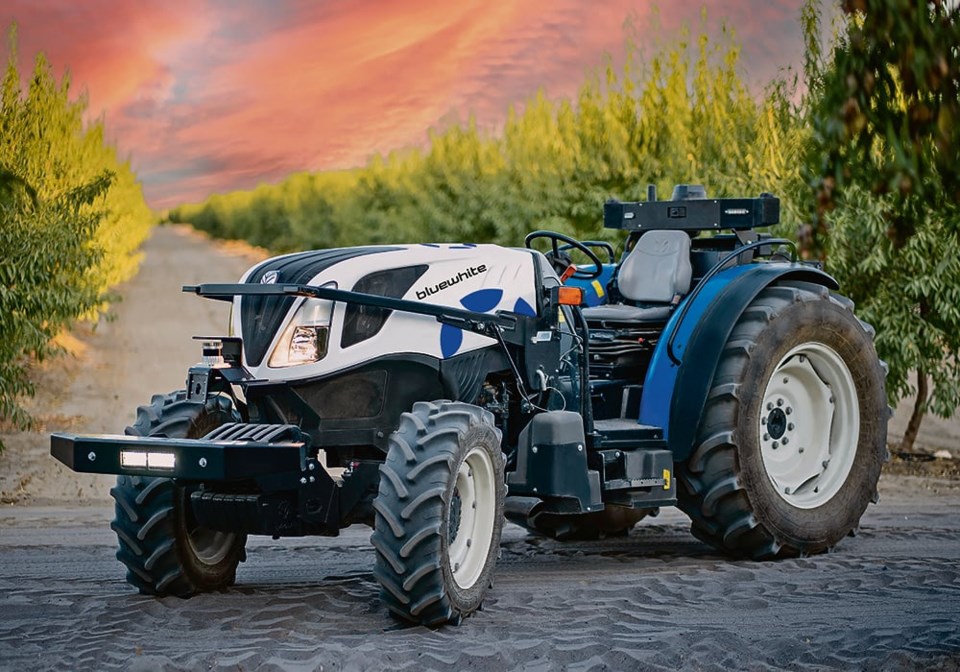WESTERN PRODUCER — Alon Ascher, chief business officer at Bluewhite, an autonomous systems company, believes adopting the newest technologies on a farm isn’t something that can easily happen in one single step.
So, as his company works with growers to incorporate self-driving tractors, he thinks it helps to make it a gradual process.
“To some extent we’re changing the way farmers work, going in the past from animals to tractors and now from tractors to robots,” he said.
“So there is a learning curve. We don’t believe in the approach of, ‘here’s your robot, your manual or YouTube video — goodbye.’ ”
The firm has a “customer success” team that spends time on the farm with each new customer helping them set up and get used to using the autonomous system.
Bluewhite, which now has a presence in California working with orchardists and other permanent crop producers, has developed an add-on system to convert 30 to 130 horsepower tractors to full autonomy. It likes to see customers ease into the transition rather than make a wholesale change all at once.
“We have a lot of focus on the adoption process that we do with the growers, basically handholding them as they move from an off-line farm to digital and data driven,” he said.
“We put a lot of emphasis on the training, the on-boarding and support. We see this as a process, not a hit and run.
“We provide an autonomous farm based on three pillars:
“The first is a kit — we call it Pathfinder — that we can install on an existing tractor and convert them to a robot.
“The second is our fleet management and data management platform — we call it Compass. That enables the operation of multiple vehicles at the same time. It’s very simple to use.
“The last is the collaboration with implements that go behind the tractors to make the job more precise, more data driven because it’s not about driving A to B; it’s about executing a specific task.”
The Pathfinder kit can be installed on a variety of tractor makes and models. It uses actuators to manually manipulate the controls on a tractor with basic control systems, essentially a low-spec model rather than one with more sophisticated features.
“Those tractors are very basic, very mechanical,” he said.
“They’re $50-, $60,- $70,000 tractors. We have low-level control, actually moving levers, rather than connect to a very sophisticated tractor computer. It gave us flexibility. We can install it on Kubota, Massey Ferguson, Fendt or whatever tractor. The models we chose are the models the customers have.”
Sticking with the most common tractors in use by potential customers also helps ease the transition to robotic operation.
“It’s already a big shift moving from regular operation to autonomous operation. If we can keep the growers’ equipment, it really assists with adoption,” Ascher said.
“A lot of companies are introducing a completely new robot that might have nice capabilities or better integration, but it’s not necessarily a good fit. So we’re using an aftermarket approach, installing (our technology) on top of existing equipment.”
The Compass cloud-based system allows growers to not only control and direct the tractor to different jobs but also allows them to track progress and accumulate field data.
“If in the past you needed to buy a rate controller, a screen in the cab and an additional connectivity package for telematics, GPS or things like that, now basically we can extract that data straight to our platform. So we have that extra control, extra information in the same app.
“Also there is a manager view, to get reports on what actually happened. There is an end of day, end of week report — this is what happened, how many acres covered, the quality of the job. We’re moving to what we call Gen 3 this season. It will have more information and user interface. So you can control, monitor and see the data on everything that’s going on.”
The system also allows operators to control an implement and change its operating parameter.
“If it’s sprayer, for example, you can set the rate, on a mower you can adjust the height needed, set different r.p.m.,” he said.
“All the functions a typical operator would do we can control. We also have what we call Bluewhite-ready, where we collaborate with an implement manufacturer to add extra sensors or controllers, things like that, to get the information to the platform.”
There is a US$35,000 to $50,000 one-time setup fee and an $20,000 to $30,000 annual subscription per tractor, depending on the operation’s requirements.
Bluewhite began full commercial sales of the system in California in 2022.
“Operationally, not in testing work, we’ve done around 50,000 operational hours across 140,000 to 150,000 acres, spraying, discing for various customers,” Ascher said.
Bluewhite is in the process of expanding its sales and distribution along the U.S. west coast, but Ascher said it has plans for eventual expansion across all of North American and into Europe and Australia.
The company currently has a waiting list for its systems, and Ascher thinks autonomous equipment is going to soon become the norm on many operations.
“Generally speaking, I think these are transformational years in ag,” he said.
“Growers are saying, ‘if I don’t adopt this, I won’t survive.’ It’s come from a luxury to a necessity. We’ve moved from discussing it only with innovators. We’re starting to see late adopters, the followers that take their time. They want to see it on other customers’ farms. There’s significant progress in customer adoption.
“Four of five years ago it looked a little bit like science fiction, having a robot on your farm. Now, it’s not.”




